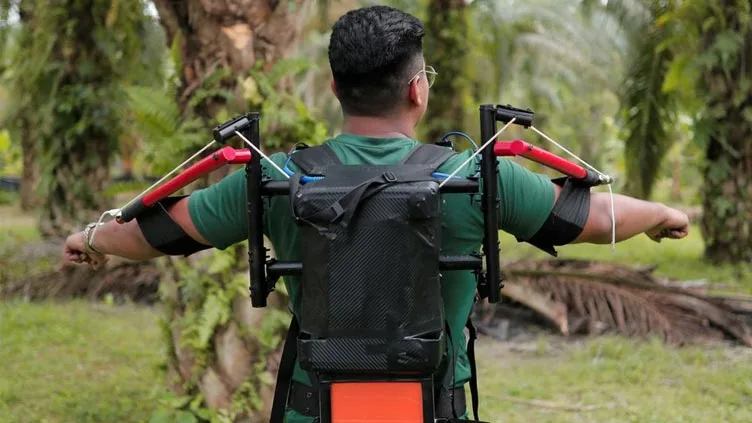YONG PENG, Oct 9(ABC): Malaysian research student Haziq Ramli wore an outfit resembling a light jetpack, with poles strapped to his biceps, to wield a long pole that clipped the sharp fronds and heavy bunches of fruit from oil palm trees nearly twice his height.
Working on a three-acre (1.2-hectare) family estate, he was part of a team trying to perfect the gadget, called a wearable exoskeleton, that promises to reduce the need for labourers to manipulate the poles, which can weigh as much as 8 kg (18 lbs).
“My arms are supported when I’m holding the pole, I feel less strain and fatigue,” said Haziq, who wore sneakers and spectacles.
Plantation firms in the world’s second biggest producer of palm oil are stepping up mechanisation to stem losses running into billions of dollars as fruit goes unharvested during their worst labour shortage yet.
“To harvest 10 tonnes of palm fruits a month, we need two workers,” said estate owner Hamidon Salleh.
Hamidon, who is also an engineer, said he and his colleagues at Malaysia’s University of Technology (UTM) were working with top producer Sime Darby Plantation (SIPL.KL) to test the gadget.
“With this exoskeleton, one harvester can achieve 10 tonnes on his own,” he added. “We can do the same amount of work with fewer workers.”
Peers of Sime Darby, such as IOI Corp (IOIB.KL), Boustead Plantations and FGV Holdings (FGVH.KL) are stepping up use of drones to spray crops with fertiliser and pesticide, map estate holdings and monitor the condition of trees.
Sime Darby said it was working with technology partners, but did not identify them. Boustead and FGV did not respond to requests for comment.
IOI said it had doubled its 2022 budget for automation and mechanisation from last year, while greater use of machines such as drones, electric wheelbarrows and motorised palm cutters has helped slash labour needs by a quarter.
Malaysian producers are racing to mechanise as they face a third annual fall in output, along with losses estimated at 20 billion ringgit ($4.4 billion), because of the labour crunch.
Yields plummeted to near 40-year lows in the 2020/21 marketing year, worsening a global shortage of edible oils triggered by the Russia-Ukraine war.
Almost 80% of Malaysia’s plantation workers are migrants, many recruited from neighbouring Indonesia to do the back-breaking work of harvesting, but pandemic curbs caused a shortfall of about 120,000 workers this year.
And supply is only expected to dry up further in coming years, making hiring more expensive.
“We’ve seen that the industry is starting to invest more in mechanisation because of the labour shortage,” said Ahmad Parveez Ghulam Kadir, the chief of the state-run Malaysian Palm Oil Board (MPOB). “The trend is rising.”
Efforts to automate had been slow while producers had easy access to cheap migrant labour able to navigate plantation terrain challenging to machines.
COVID CHANGES
The coronavirus pandemic has changed that.
“COVID-19 has accelerated the digital transformation in plantations much faster,” said Razalee Ismail, director of drone services provider Meraque. “Companies are now much more willing to spend and experiment with technology.”
Demand for the firm’s drone spraying services have surged since the start of the pandemic, pushing the expansion of its fleet to 62 from three in 2018, though Razalee said the company needed to add 100 more to meet demand.
A single drone using artificial intelligence to detect trees and spray nutrients can do the work of six people, he added.
Meraque counts FGV, Boustead and Sime Darby as customers.
If Malaysia’s use of manpower goes unchecked, rising wages could combine with dwindling output to boost costs and hurt competitiveness against larger exporter Indonesia and emerging producers in Africa, India and Latin America.
Late last year, Malaysia’s business and government pumped 60 million ringgit ($13 million) into research and development of automated harvesting technology.
Their ambitious goal is to slash the workforce over the next five years, to a ratio of one worker for every 50 hectares (124 acres) from one for every 10 hectares (25 acres) now, with a long-term goal of one for every 100 hectares (247 acres).
“We cannot be complacent as we’ve been before,” added Ahmad Parveez of the state board.
In rival Indonesia, some producers are adopting digital apps to optimise workflows and costs, although at a cautious pace, aware that mechanisation could threaten livelihoods.
NO QUICK FIX
Still, experts say automation will not phase out manual labour very soon. Few existing machines can tackle the vast undulating spaces and towering palm trees of plantations as efficiently as workers.
New tools could ease Malaysia’s woes, but many are in their infancy and will need years of development, said Khor Yu Leng, director of economic consultancy Segi Enam Advisors.
Flights by most battery-powered drones last just 15 minutes, while existing exoskeletons do not speed harvesters’ movements and can cost tens of thousands of ringgit, she said.
Hazlina Salamat, UTM’s lead researcher on exoskeletons for the palm industry, is working on one shown in tests to reduce muscle strain by 22% and increase endurance by 47%, she said.
Despite wanting to modernise, the industry is cautious about big investments, Hazlina said, adding, “A lot of these technologies have to be proven first.”

